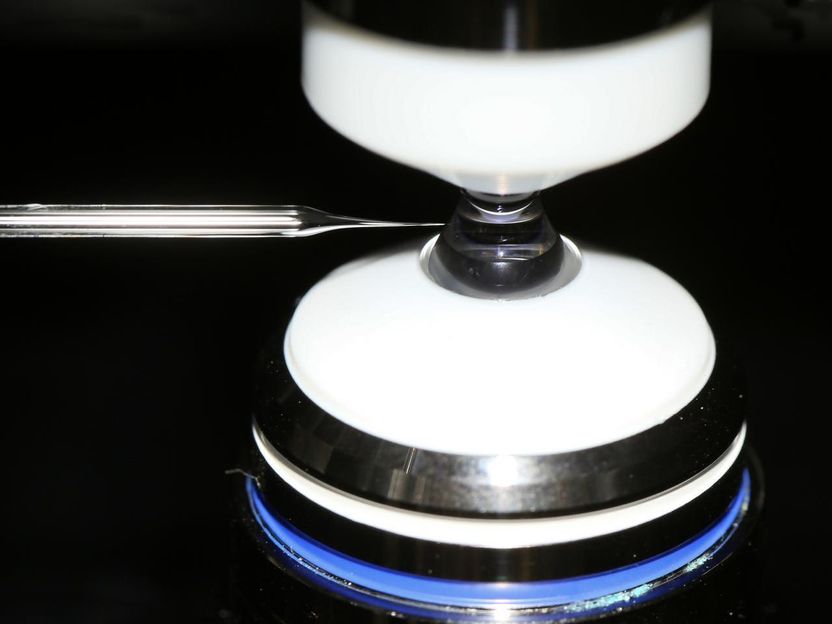Alzheimer's early detection up to 17 years in advance
A sensor detects misfolded protein biomarkers in blood
The dementia disease Alzheimer's disease has a 15 to 20 year symptom-free course before the first clinical symptoms appear. Using an immuno-infrared sensor developed in Bochum, a research team was able to identify signs of Alzheimer's disease in the blood up to 17 years before the first clinical symptoms appear. The sensor detects the misfolding of the protein biomarker amyloid-beta. As the disease progresses, this misfolding causes characteristic deposits in the brain called plaques.
"Our goal is to determine the risk of later developing Alzheimer's dementia with a simple blood test even before the toxic plaques can form in the brain - so that therapy can start in time," says Prof. Dr. Klaus Gerwert, founding director of the Center for Protein Diagnostics (PRODI) at Ruhr University Bochum. His team cooperated for the work with a group at the German Cancer Research Center in Heidelberg (DKFZ) led by Prof. Dr. Hermann Brenner.

© RUB, Marquard
Early detection of symptom-free individuals at high risk of Alzheimer's disease
The researchers analyzed blood plasma from participants in the ESTHER study conducted in Saarland for potential Alzheimer's biomarkers. The blood samples had been taken between 2000 and 2002 and then frozen. At that time, the subjects were between 50 and 75 years old and had not yet been diagnosed with Alzheimer's disease. For the current study, 68 participants who had been diagnosed with Alzheimer's disease during the 17-year follow-up were selected and compared with 240 control subjects without such a diagnosis. The team led by Klaus Gerwert and Hermann Brenner wanted to know whether signs of Alzheimer's disease could already be found in the blood samples at the beginning of the study.
The immuno-infrared sensor was able to identify the 68 test subjects who later developed Alzheimer's disease with a high degree of test accuracy. For comparison, the researchers investigated other biomarkers using the complementary, highly sensitive SIMOA technology - in particular the P-tau181 biomarker, which is currently being proposed as a promising biomarker candidate in various studies. "In contrast to the clinical phase, however, this marker is not suitable for the early symptom-free phase of Alzheimer's disease," said Klaus Gerwert, summarizing the results of the comparative study. "Surprisingly, however, we found that glial fiber protein (GFAP) concentration can indicate the disease up to 17 years before the clinical phase, but much less precisely than the immuno-infrared sensor." However, by combining amyloid-beta misfolding and GFAP concentration, the researchers were able to further increase the accuracy of the test in the s
ymptom-free state.
Start-up aims to bring immuno-infrared sensor to market
The Bochum researchers hope that early diagnosis based on amyloid-beta misfolding could help them use Alzheimer's drugs in time to make them work much better - for example, the drug Aduhelm, which was recently approved in the United States. "We want to use the misfolding test to establish a screening method for older people and determine their risk of developing Alzheimer's dementia," says Klaus Gerwert. "The vision of our newly founded start-up betaSENSE is that the disease can be stopped in a symptom-free state before irreversible damage occurs." The sensor is still in the development phase. However, the invention has already been patented worldwide. BetaSENSE aims to bring the immuno-infrared sensor to market and to approval as a diagnostic device so that it can be used in clinical laboratories.
Clinical trials of Alzheimer's drugs often fail
Aduhelm, a drug approved by the FDA in the U.S. in spring 2021, has been shown to break down early-stage amyloid-beta plaques. However, previous studies have found little effect on clinical symptoms such as memory loss and disorientation. As a result, the European Medicines Agency decided in winter 2021 not to approve the drug in Europe. "So far, rows of clinical trials for Alzheimer's drugs have apparently failed because the therapeutic approaches were too late, because the established plaque tests used in the trials apparently do not indicate the disease in time," Gerwert said. "Apparently, once plaques are deposited, they produce irreversible damage to the brain." In the tests used to date, the plaques are either detected directly in the brain using the complex and expensive PET scan technology or determined indirectly in a less complex manner using protein biomarker concentrations in the invasively obtained nerve
nwater using ELISA or mass spectrometry technology. In contrast to established plaque diagnostics, the immuno-infrared sensor indicates the earlier misfolding of amyloid-beta, which causes subsequent plaque deposition. "However, there is still controversy as to whether this misfolding is causative or merely concomitant to Alzheimer's disease," Gerwert said. "For the therapeutic approach, this question is very crucial, but irrelevant for the diagnosis. Misfolding indicates the onset of Alzheimer's disease."
"The exact timing of therapeutic intervention will become even more important in the future," expects Léon Beyer, first author and PhD student in Klaus Gerwert's team. "The success of further drug trials will depend on study participants being correctly characterized and not yet showing irreversible damage at study entry."
Biomarkers for Parkinson's and ALS
Misfolded proteins play a central role in many neurodegenerative diseases, such as Parkinson's disease, Huntington's disease, and amyotrophic lateral sclerosis (ALS). In principle, the immuno-infrared sensor also works for detecting other misfolded proteins, such as TDP-43, which is characteristic of ALS, the researchers recently showed. They do not measure the concentration of a specific protein, but detect its misfolding. With the help of disease-specific antibodies. "In particular, this platform technology allows differential, precise biomarker-based diagnosis in the early stages of neurodegenerative diseases, where the previous symptom-based diagnosis is very difficult and prone to errors," Gerwert said.
Note: This article has been translated using a computer system without human intervention. LUMITOS offers these automatic translations to present a wider range of current news. Since this article has been translated with automatic translation, it is possible that it contains errors in vocabulary, syntax or grammar. The original article in German can be found here.
Original publication
Léon Beyer, Hannah Stocker, Dan Rujescu, Bernd Holleczek, Julia Stockmann, Andreas Nabers, Hermann Brenner, Klaus Gerwert: "Amyloid-beta Misfolding and GFAP Predict Risk of Clinical Alzheimer's Disease Diagnosis within 17 years" Alzheimer's & Dementia: The Journal of the Alzheimer's Association, 2022.
Hannah Stocker, Léon Beyer, Laura Perna, Dan Rujescu, Bernd Holleczek, Konrad Beyreuther, Julia Stockmann, Ben Schöttker, Klaus Gerwert, Hermann Brenner: "Association of plasma biomarkers, P-tau181, glial fibrillary acidic protein, and neurofilament light, with intermediate and long-term clinical AD risk: Results from a prospective cohort followed over 17 years," Alzheimer's & Dementia: The Journal of the Alzheimer's Association, 2022.





















































